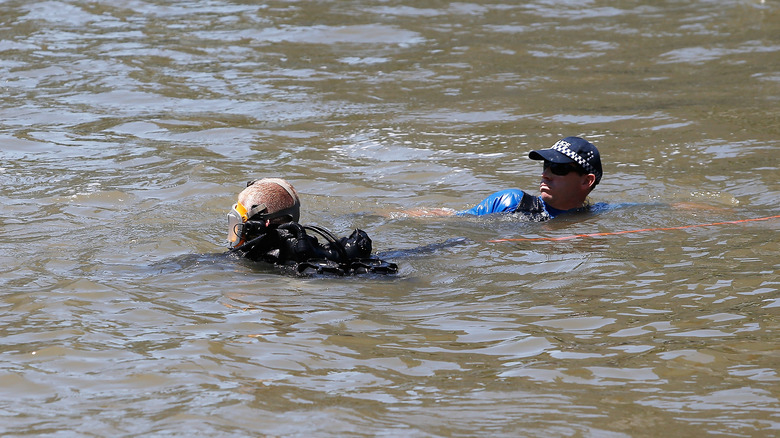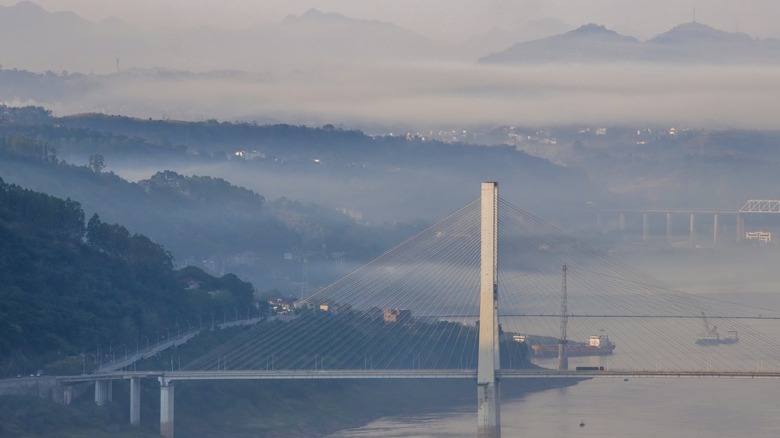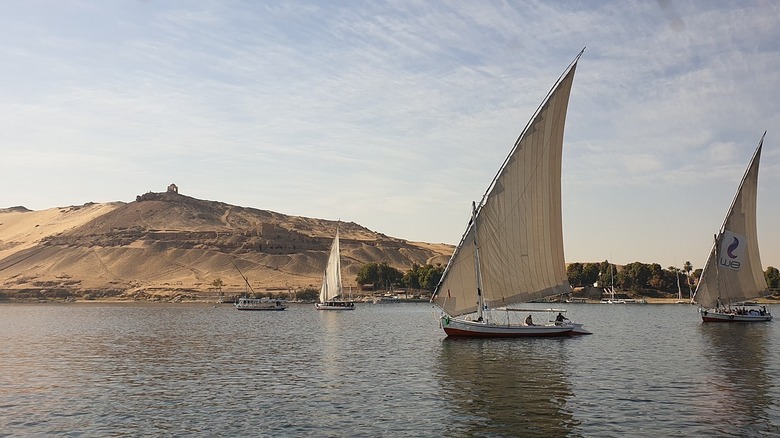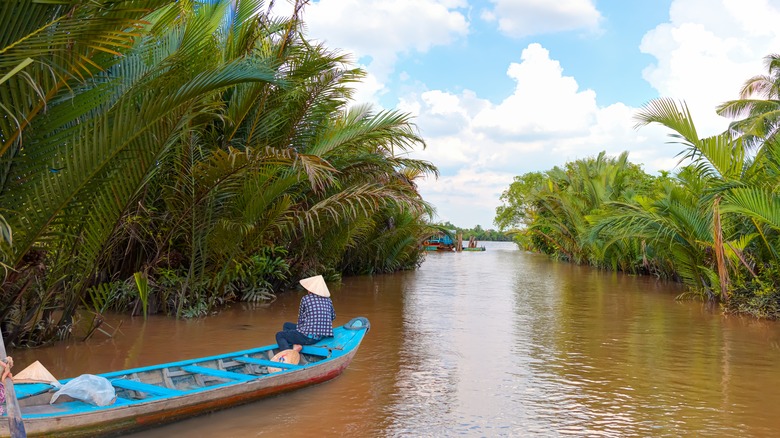These Are The Most Dangerous Rivers In The World
By this point, everyone's pretty aware that oceans are terrifying. There are spooky creatures living in the deepest, darkest depths, rip tides waiting to carry away even the strongest of swimmers, and the bone-chilling fact that we've only explored about 5% of the Earth's underwater world. To fear the ocean is a no-brainer. But rivers ... well, they just don't get the respect they deserve, considering how dangerous they can be.
Around the world, there are dozens of rivers that have amassed considerable body count. From pollutants to strong currents to violent creatures lurking within their waters, some rivers can present a legitimate threat to human life even though they play a crucial role in the development of human society. Of course, not all rivers are built the same, and the stream down the street from your grandparents' house has a different level of risk than a powerful waterway churning with rapids. Here are some of the most dangerous rivers in the world so you know which ones to approach with caution.
Brisbane River, Australia
It shouldn't come as a surprise that Australia made this list — after all, its natural landscape seems uniquely committed to terrifying humans whenever possible. The Brisbane River has inhabitants that make it especially frightening for visitors: It's home to up to 3,000 bull sharks. These enterprising apex predators are equally comfortable in salt and fresh water, explaining why they inhabit rivers and oceans. They're considered a particularly aggressive species of shark, one responsible for a large percentage of (still relatively rare) unprovoked shark attacks on humans.
But if you thought the bull shark was the only reason to fear and respect the Brisbane River, buckle up. It's also known for extremely powerful currents, debris from storms and floods that can become dangerous obstacles for people caught in it, and poor water quality, which has earned it the ominous nickname "The Brown Snake." While we're here, check out the most dangerous wildlife to avoid in Australia.
Kern River, United States
You don't have to be a genius to give a river that has earned the nickname "Killer Kern" a wide berth. Running from the Sierra Nevadas to Bakersfield, California, the Kern River uses melted snow from the mountains to generate powerful currents and world-class rapids. As a result, it's popular among kayaking enthusiasts, but that doesn't mean it should be at the top of every tourist's list, especially if you don't have significant experience navigating troublesome waterways.
If wanderers unaware of its dangers stumble upon the river, local authorities have spent about $100,000 to get the word out. They have installed signs in English and Spanish that display "Stay Out, Stay Alive" and the number of fatalities in the Kern since 1968. In May 2024, it was updated to 335. There have been at least two deaths reported since then. Considering the risks involved, it might just be worth staying away.
Shanay-Timpishka, Peru
Many rivers are dangerous because they contain elements that make it much easier for things to go wrong when people swim or boat in them. But the Shanay-Timpishka River in Peru, which translates to "boiled with the heat of the sun," is not as tolerating. Simply setting foot in the river can be lethal as it boasts extremely high temperatures of around 212 degrees Fahrenheit. This can cause third-degree burns in seconds; animals, unfortunately, are not as lucky as they die instantly when they fall into it.
La Bomba, its other name, has long been a component of local healing rituals. However, its remote location deep in the jungles of the Peruvian Amazon has meant that it has only recently begun to be studied by scientists for its unique properties. Although you can arrange for a guide to bring you to the river, it's certainly recommended to proceed with caution.
Rio Tinto, Spain
Upon reaching the Rio Tinto in Spain, you will notice its distinct coloration of deep reds and oranges. This is not, unfortunately, just one of nature's strange, beautiful quirks but rather the extreme result of local pollution. The Rio Tinto area has long been associated with mining, which contaminated the river with chemicals and heavy metals, making it highly acidic. It has a pH level of 2.3, which puts it on roughly the same acidity level as lemon juice. So naturally, it's probably not the best place to go for a swim unless you're at the mouth of the river where it meets the Bay of Huelva. Here, its chemical qualities are diluted.
With such a low pH level, the Rio Tinto is incapable of supporting life aside from some hardy bacteria. According to recommendations for the maintenance of pools, a pH level lower than seven will sting swimmers' eyes, so you can only imagine how uncomfortable it would be to splash some of this river's water on your body.
Amazon River, South America
There's a reason why the Amazon River, like the Oregon Trail, earned itself an educational computer game from MECC in the early 1990s — traversing it makes for one treacherous journey. Where to start? The Amazon River, which crosses much of South America, is home to a smorgasbord of terrifying creatures. These include the green anaconda (which can grow up to an astonishing 20 feet long), red-bellied piranhas, the famously territorial bull shark, the arapaima, which can reach up to 15 feet in length, and black caimans.
And that's just the creatures you might find in the river. You also have to contend with the strong currents of the Amazon, which can be dangerous for swimmers. There are additional pollution-related reasons to be wary of the Amazonian waters: Parts of the Amazon have unsafe levels of mercury, thanks to illegal gold mining practices in the region. Check out the dangerous animals you wouldn't want to encounter in the Amazon Rainforest.
Vishwamitri River, India
Each danger in India's Vishwamitri River doesn't create much cause for alarm. However, once compounded, they escalate as a unit, creating a particularly unsafe environment. First of all, the Vishwamitri River is home to over 1,000 crocodiles. Under ordinary circumstances, they mostly keep to themselves — except during significant flooding, which happens fairly regularly to the Vishwamitri River.
This wouldn't be too much of a problem if it occurred in a nice, isolated area where the displaced crocodiles would do relatively little harm. But as it stands, the Vishwamitri River flows directly through the Gujarat city of Vadodara, home to over 2 million people. So when it floods, the crocodiles have to go somewhere; often, they choose Vadodara. We don't have to tell you that it's less than ideal. In August 2024, hundreds of crocodiles were stuck in the city, some even trapped on rooftops until disaster response forces rescued them.
River Wharfe, United Kingdom
Out of all the rivers on this list, River Wharfe in the Yorkshire Dales National Park of England is probably the most seemingly unassuming. When you look at it, you don't immediately see what the big fuss is all about. After all, at first glance, it looks calm and sedate — perhaps even the perfect venue for a quick summer swim. But underneath the surface — both figurately and literally — the River Wharfe is unexpectedly threatening, especially in the stretch known as the Strid.
While the Strid is relatively narrow, at its deepest, it measures an astonishing 213 feet, which is about 30 feet taller than the Leaning Tower of Pisa, in case you need a height comparison. According to locals, it has a 100% mortality rate, meaning everyone who has ever fallen into the Strid has drowned. It's so legendarily dangerous at this point that it's been immortalized in "The Founding of Bolton Abbey," a poem by William Wordsworth that tells the story of a young man who attempted to jump across the Strid — with deadly consequences.
Tarcoles River, Costa Rica
The Tarcoles River in Costa Rica is the unhappy recipient of San Jose's waste, as the capital city's pollutants flow freely into it. In 2017, it was given the unflattering title of the most polluted river in Central America, a status that Costa Rica has since sought to counteract (with mixed results). But the fact that the Tarcoles River is toxic isn't why it makes an appearance on this list. It's because of the large numbers of American crocodiles that call this river home.
There's even the famous Crocodile Bridge, where intrepid tourists could inch along its narrow shoulder knowing they could plummet into the crocodile-infested waters below (in 2020, they widened the bridge, making it a much less dangerous affair). Although crocodile fatalities are relatively rare, they still occur. In 2023, a Costa Rican footballer was killed in a crocodile attack while swimming in the Tarcoles River. Non-fatal attacks have also increased as the crocodile's habitat is threatened, forcing them to venture closer to humans for food.
Murray River, Australia
Murray River has the distinction of being Australia's most deadly inland river. Unlike some other rivers on our list, which you can tell are dangerous almost immediately, Murray River has a number of hidden threats. For one, although it seems relatively calm, it has a deceptively strong water flow, with rip currents forming and creating pockets of great depth surprisingly close to the shoreline, which can be a problem for swimmers. The Murray River has claimed the lives of an estimated 200 swimmers, fishermen, and boat enthusiasts through drowning.
In addition to water conditions that can overwhelm visitors who haven't taken proper precautions, it's also home to some seriously venomous inhabitants. Commonly sighted in the Murray River Basin are tiger snakes, eastern browns, and the red-bellied black snake. Although none of these are known for being particularly aggressive, they all pack a powerful punch if they feel threatened. The eastern brown has the second most potent venom of any snake species in Australia, and the venom of the tiger snake causes paralysis and death if not promptly treated.
Yenisei River, Russia
Most people are already familiar with the fact that Siberia is widely considered an inhospitable region — it was the go-to place to send prisoners and political dissidents for centuries in Russia. However, many may not be aware that the Yenisei River in Siberia is just as unwelcoming as the region's frequently challenging climate. This is largely thanks to its proximity to the Mining and Chemical Combine (MCC), which was constructed in 1950 and is Russia's leading producer of weapons-grade plutonium (although now that the Cold War is over, it primarily provides heat and electricity for the surrounding area).
Because the waters of the Yenisei were used as a coolant for the nuclear reactors, they are now contaminated with radioactive particles, even though the reactors have been closed for years. High radiation levels have been found in both the river and its banks — in some areas hundreds of times above what is considered safe — which has caused issues for the local community, many of whom fish in the Yenisei and have cattle grazing nearby.
Zambezi River, Africa
For many whitewater rafting enthusiasts, the Zambezi River — which stretches from Mozambique along the Zimbabwe-Zambia border into Angola — is a bucket list destination. It has Class 5 rapids, the ultimate for thrillseekers worldwide. And the awe-inspiring presence of the Victoria Falls makes it a must-do for many. But it also has plenty of dangers beyond those presented by its rapids, which can be navigated with experience.
Like many of the other waterways on this list, The Zambezi River is home to some unsavory elements — in this case, crocodiles and hippos. They pose a threat to visitors, who may not immediately realize how deadly they can be under the wrong circumstances. The Zambezi River is also known to have a number of unexploded landmines in it and along its riverbanks, a result of old, bloody wars in the region. Similarly, Angola is one of the most heavily landmined countries in the world, a problem they're working feverishly to fix.
Yangtze River, China
Located in China, the Yangtze River is the third-longest in the entire world, running for nearly 4,000 miles. It's an essential artery for the many communities that have sprouted along its riverbanks over the centuries, with millions of people living in its flood plains. But it is this propensity for flooding that makes the Yangtze such a dangerous river, especially considering the large number of inhabitants impacted by its water-level fluctuations. Within the past 100 years, the flooding of the Yangtze River has claimed the lives of hundreds of thousands — maybe even millions, based on some estimates — and caused billions of dollars worth of damages.
But that's not all. The Yangtze's flooding issues also make the river dangerous in different ways. The constantly changing water levels make it extremely difficult to navigate, and when the water levels are high, it boasts strong currents and crushing rapids.
Nile River, Africa
The Nile, which has been central to the development of Egyptian culture for thousands of years, is one of the most famous rivers in the world. But it's also, to be completely honest, one of the more dangerous spots you could pick for a swim or boating adventure. Firstly, there are bands of crocodiles, hippos, and venomous snakes, all of which can prove fatal for humans in an unlucky encounter. The water quality issues of the Nile can also be burdensome: Studies have shown that it has levels of bacteria that can cause disease. Additionally, the Nile has a pesky mosquito population, which carries with it the risk of causing dengue fever, malaria, and the West Nile Virus.
It's worth noting that because the Nile is such a long river, there are parts of it that go through active conflict zones, such as Sudan, which creates additional risks. There have been reports of gunfire from one bank of the Nile to the other in Khartoum as recently as November 2023. Lastly, the Nile also has strong currents and rapids as the water flow fluctuates, which may be more conventional concerns for river enthusiasts but are still quite dangerous in their own right.
Mekong River, Asia
The Mekong is one of the longest rivers in Asia, flowing through China, Myanmar, Laos, Cambodia, Thailand, and Vietnam — unfortunately, it's also one of the most dangerous. Its water levels vary dramatically, making it incredibly difficult to navigate. Even if you're a local, you're rarely going down the same river twice because of its constant changes. All of this is before taking into account the Mekong's many rapids and waterfalls, which can catch folks unaware.
An additional danger associated with the Mekong is the presence of landmines in some parts of the river left over from the conflict in the region during the 1970s and 1980s — unexploded aerial bombs have been recovered from the river. Extra care must be taken while in the Golden Triangle, the area where the currently volatile Myanmar, Thailand, and Laos meet: It's not uncommon for boats on this trade route to be hijacked or raided.
Congo River, Africa
The Congo River plays such a key role in Central Africa that there are two countries that share its name (the incredibly biodiverse Republic of the Congo and the Democratic Republic of the Congo). But although it serves as a lifeline connecting remote locations in the region, it also contains a multitude of dangers. Like many of the other rivers on this list, it has strong, unpredictable currents that can prove deadly for those unfamiliar with its quirks.
It also has plenty of hazardous wildlife, including Nile crocodiles, black mambas (considered by many to be the most dangerous snakes in the world, with their well-documented aggression and venom that can kill a human with just two drops), and even the occasional shark. However, the aspect of the Congo River that makes it so risky for visitors and locals alike is that it — almost without exception — flows through dense jungles and remote areas. This means that if anything were to happen to you on a trip to the river, help is a very long way away.















